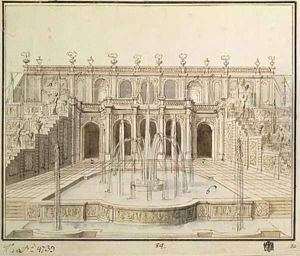Niccolo Michetti Paintings
Niccolò Michetti, born in 1675 in Rome, Italy, emerged as a prominent architect of the Baroque period, contributing significantly to the architectural landscape of early 18th-century Europe. Though initially lesser known compared to his contemporaries, Michetti's work has gained appreciation for its intricate designs and the seamless integration of architecture with surrounding landscapes and gardens.
Michetti's early years were marked by his study under the tutelage of prominent architects of the time, which included Carlo Fontana, one of the most influential architects in Rome during the late 17th century. This apprenticeship was crucial in shaping Michetti's architectural philosophy and skills, embedding in him the principles of Roman Baroque architecture, which he would later adapt and evolve in his own projects.
His career took a significant turn when he was invited to Russia by Tsar Peter the Great, who was looking for architects to contribute to his ambitious project of modernizing and expanding the city of Saint Petersburg. Michetti's work in Russia, including his designs for the Kadriorg Palace in Tallinn, Estonia, showcased his ability to blend Italian Baroque elements with the local context, earning him recognition and acclaim.
After his stint in Russia, Michetti returned to Italy, where he continued his work, focusing particularly on religious buildings and villas. His designs often featured elaborate gardens and the use of water, reflecting his interest in integrating natural elements with architectural structures. Despite facing competition from other prominent architects of his time, Michetti's works remained distinctive for their elegance and harmony.
Michetti's legacy is not confined to his buildings but also includes his contributions to the urban planning of the cities where he worked. His approach to architecture, emphasizing the balance between built structures and their environment, has been influential in the development of architectural theory. Niccolò Michetti passed away in 1759, leaving behind a body of work that continues to be studied and admired for its artistic and historical significance. His contributions to Baroque architecture, particularly in the context of the Roman and Russian environments, underscore his role as a key figure in the transition towards more integrated and harmonious architectural designs.
